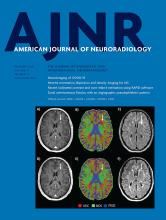Research ArticlePediatric Neuroimaging
Open Access
Longitudinal Assessment of Neuroradiologic Features in Wolfram Syndrome
A. Samara, H.M. Lugar, T. Hershey and J.S. Shimony
American Journal of Neuroradiology December 2020, 41 (12) 2364-2369; DOI: https://doi.org/10.3174/ajnr.A6831
A. Samara
aFrom the Department of Psychiatry (A.S., H.M.L.)
H.M. Lugar
aFrom the Department of Psychiatry (A.S., H.M.L.)
T. Hershey
aFrom the Department of Psychiatry (A.S., H.M.L.)
bNeurology (T.H.)
cMallinckrodt Institute of Radiology (T.H., J.S.S.), Washington University School of Medicine, St. Louis, Missouri
J.S. Shimony
cMallinckrodt Institute of Radiology (T.H., J.S.S.), Washington University School of Medicine, St. Louis, Missouri

References
- 1.↵
- Amr S,
- Heisey C,
- Zhang M, et al
- 2.↵
- Inoue H,
- Tanizawa Y,
- Wasson J, et al
- 3.↵
- 4.↵
- Takei D,
- Ishihara H,
- Yamaguchi S, et al
- 5.↵
- 6.↵
- 7.↵
- 8.↵
- 9.↵
- 10.↵
- 11.↵
- 12.↵
- 13.↵
- Gocmen R,
- Guler E
- 14.↵
- Ito S,
- Sakakibara R,
- Hattori T
- 15.↵
- Scolding NJ,
- Kellar-Wood HF,
- Shaw C, et al
- 16.↵
- 17.↵
- 18.↵
- 19.↵
- 20.↵
- Cohen J
- 21.↵
- Landis JR,
- Koch GG
- 22.↵
- Bonneville F,
- Cattin F,
- Marsot-Dupuch K, et al
- 23.↵
- Fujisawa I,
- Asato R,
- Kawata M, et al
- 24.↵
- Kucharczyk W,
- Lenkinski RE,
- Kucharczyk J, et al
- 25.↵
- Klyn V,
- Dekeyzer S,
- Van Eetvelde R, et al
- 26.↵
- Fujisawa I,
- Nishimura K,
- Asato R, et al
- 27.↵
- 28.↵
- 29.↵
- Shepherd TM,
- Ades-Aron B,
- Bruno M, et al
- 30.↵
- Doherty D,
- Millen KJ,
- Barkovich AJ
- 31.↵
- 32.↵
- 33.↵
- 34.↵
- 35.↵
- Hoekel J,
- Narayanan A,
- Rutlin J, et al
- 36.↵
- 37.↵
- 38.↵
- 39.↵
- Galluzzi P,
- Filosomi G,
- Vallone IM, et al
In this issue
American Journal of Neuroradiology
Vol. 41, Issue 12
1 Dec 2020
Advertisement
A. Samara, H.M. Lugar, T. Hershey, J.S. Shimony
Longitudinal Assessment of Neuroradiologic Features in Wolfram Syndrome
American Journal of Neuroradiology Dec 2020, 41 (12) 2364-2369; DOI: 10.3174/ajnr.A6831
0 Responses
Jump to section
Related Articles
- No related articles found.
Cited By...
This article has not yet been cited by articles in journals that are participating in Crossref Cited-by Linking.
More in this TOC Section
Similar Articles
Advertisement











